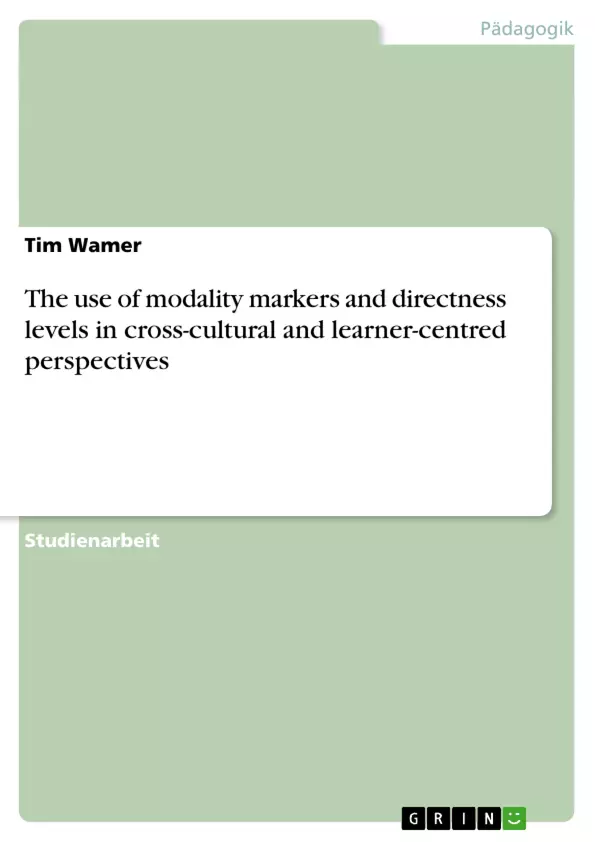Linguistic politeness is an important subcategory of pragmatics, as it is essential for the success of communication, which in turn is a central aspect of pragmatics. It is not a fixed and defined category because it differs from one speech community to another and can be realised by different means, such as lexical or phrasal ones. This term paper considers both by analysing the directness and the modality markers used in three situations eliciting complaints. A questionnaire was handed out to members of the following four groups: native speakers of English, young German learners of English, advanced German learners of English, all writing in English, and native speakers of German writing in German.
We analyse the hypothesis of House and Kasper (1981, p. 162) stating that native speakers of German are more direct than native speakers of English. However, it has to be mentioned that their survey was based on spoken language.
A second aspect of our study is the analysis of learner language. We want to examine if L2-learners are more direct and thus less polite than native speakers of the target language. The influence of their competence in the second language and the impact of their mother tongue on second language acquisition are taken into account here.
Wolfson (1989, pp. 129-139) showed that social distance between the interlocutors has influence on politeness regarding invitations and compliments. This term paper examines if this Bulge Theory is also valid for other speech acts such as complaints and requests.
After an overview on linguistic approaches on politeness, the questionnaire and the criteria of our analysis are presented. The next chapter deals with the evaluation and interpretation of the data and focuses on the aspects mentioned above. A short conclusion sums up the main results.
Inhaltsverzeichnis
- 1 Introduction
- 2 Pragmatics and Politeness - An Overview
- 2.1 Cross-Cultural Differences
- 2.2 Indirectness
- 2.3 Modality Markers
- 2.4 The Bulge Theory
- 3 The Questionnaire
- 4 Criteria for our Analysis
- 4.1 Directness Levels
- 4.2 Modality Markers
- 4.2.1 Upgraders
- 4.2.2 Downgraders
- 5 Results and Interpretations
- 5.1 A General Overview
- 5.1.1 Directness Levels
- 5.1.2 Upgraders
- 5.1.3 Downgraders
- 5.2 Situation 1
- 5.2.1 Directness Levels
- 5.2.2 Upgraders
- 5.2.3 Downgraders
- 5.3 Situation 2
- 5.3.1 Directness Levels
- 5.3.2 Upgraders
- 5.3.3 Downgraders
- 5.4 Situation 3
- 5.4.1 Directness Levels
- 5.4.2 Upgraders
- 5.4.3 Downgraders
- 5.5 The Bulge Theory
- 5.6 The use of please and bitte
- 6 Conclusion
Zielsetzung und Themenschwerpunkte
Die vorliegende Arbeit untersucht die Verwendung von Modalitätsmarkern und Direktheitsstufen in interkultureller und lernerzentrierter Perspektive. Sie zielt darauf ab, die Hypothese von House und Kasper (1981) zu überprüfen, wonach deutsche Muttersprachler direkter sind als englische Muttersprachler. Darüber hinaus untersucht die Arbeit, ob L2-Lerner direkter und somit weniger höflich sind als Muttersprachler der Zielsprache.
- Interkulturelle Unterschiede in der Verwendung von Modalitätsmarkern und Direktheitsstufen
- Der Einfluss der Muttersprache auf die Zweitspracherwerb
- Die Gültigkeit der Bulge-Theorie für Beschwerdeäußerungen
- Die Rolle von Modalitätsmarkern in der Höflichkeit
- Die Verwendung von "please" und "bitte" im interkulturellen Kontext
Zusammenfassung der Kapitel
Die Arbeit beginnt mit einer Einführung in die Thematik der sprachlichen Höflichkeit und stellt den theoretischen Rahmen für die Analyse dar. Kapitel 2 bietet eine Übersicht über die Pragmatik und die Höflichkeit, wobei insbesondere auf interkulturelle Unterschiede, Indirektheit, Modalitätsmarker und die Bulge-Theorie eingegangen wird. Kapitel 3 beschreibt den Fragebogen, der für die Datenerhebung verwendet wurde, und Kapitel 4 legt die Kriterien für die Analyse fest, die sich auf Direktheitsstufen und Modalitätsmarker konzentrieren. Kapitel 5 präsentiert die Ergebnisse und Interpretationen der Daten, wobei die Direktheitsstufen, die Verwendung von Upgradern und Downgraders in verschiedenen Situationen sowie die Gültigkeit der Bulge-Theorie untersucht werden. Darüber hinaus analysiert das Kapitel die Verwendung von "please" und "bitte" im interkulturellen Kontext.
Schlüsselwörter
Die Arbeit beschäftigt sich mit den Bereichen der Pragmatik, der Höflichkeit, der Modalität, der Direktheit, der interkulturellen Kommunikation, dem Zweitspracherwerb und der Bulge-Theorie. Wichtige Begriffe sind Modalitätsmarker, Upgrader, Downgrader, Direktheitsstufen, Beschwerdeäußerungen, Bitte- und Dankformulierungen sowie die Unterschiede zwischen Deutsch und Englisch.
- Citation du texte
- Tim Wamer (Auteur), 2005, The use of modality markers and directness levels in cross-cultural and learner-centred perspectives, Munich, GRIN Verlag, https://www.grin.com/document/75464



